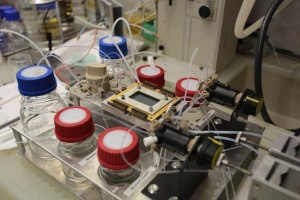Mar 11 2016
Electronic Blood
 I dislike gratuitous analogies that don’t actually facilitate your understanding of a new concept or technology, and may even be inherently misleading. A great analogy, however, is science communication gold.
I dislike gratuitous analogies that don’t actually facilitate your understanding of a new concept or technology, and may even be inherently misleading. A great analogy, however, is science communication gold.
I was intrigued by articles discussing “electronic blood.” What exactly is it, and is the blood analogy gratuitous or helpful? In the end I think it was fairly accurate.
Electronic blood is not yet ready for the market, it is still in the research and development stage. It is also not an electronic replacement for biological blood, but a blood-like replacement for electronic power and cooling. The ideas is to both power and cool computer chips with a redox fluid that can provide energy through oxidation and then be recharged through reduction. At the same time the fluid can carry heat away from the processor.
The blood analogy is actually perfect. Blood carries energy to every cell while carrying away waste. Electronic blood would carry energy to every part of a computer chip while carrying away waste heat.
Is a fancy new system of delivering power to a computer chip really necessary? You bet. Here is an in-depth technical article explaining everything, but let me hit the high points.
As computer chips get smaller we are running into several technological limitations. One is providing power, and another is dissipating heat. Most of those tiny connectors on a CPU are actually there to deliver power, not information. As designers are looking to stack computer chips in order to cram more computing power into computers, getting the power to every part of the stack becomes more and more challenging.
Further, those smaller chips are also packing more heat production into a smaller area, which means a smaller surface area with which to dissipate that heat – less surface making contact with heat sinks, for example.
Electronic blood could solve both problems. Bathing the chips in fluid that delivers energy and carries away heat could enable 3D stacking of computer chips to push designs for greater computing power. IBM is currently working on what they call 5D technology – three physical dimensions plus power and cooling.
Technology Imitating Life
I also found the idea of electronic blood intriguing because of its possible implications for future technology. It is interesting to think about the future trajectory of technology, and one specific question is how much technology will replicate biological systems.
Biological systems are just complex machines, and they have had billions of years of evolution to work out many engineering problems. For example, as advanced as our current supercomputers are, they are orders of magnitude less efficient than human brains. Our brains use much less energy per unit of information processing than computers, and we have the whole heat problem solved.
Looking to biological systems for inspiration is only one motivation for imitating biology, however. Another is our desire to interface technology with biology. Already we are working on machine-brain interfaces, but are running into technological limitations, including the need to power the technology, heat dissipation, and scar tissue formation.
Our brains happily communicate with and even adapt to electrodes placed near or in contact with them, but with the limitations mentioned above. Deliberately making computer chips that are more biological would solve a lot of problems.
Properties that an ideal computer-brain interface would have include being flexible, using very little energy and producing very little waste heat, being biologically compatible (no rejection or scar tissue), and even being powered by biological activity itself so that an external power source is not necessary. It seems likely that as we move in this direction our computer chips will look more squishy (biological) and may even duplicate some biological principles.
Electronic blood does sound like one step in this direction.
Conclusion
As we push the limits of computer chip technology we are running into fundamental physical limitations, include mundane things such as heat dissipation. However, biological systems are to some extent a proof of concept, that systems with orders of magnitude greater efficiency are physically possible.
While it is difficult to impossible to predict the future course of technology beyond 5-10 years, it is interesting to consider how the interface of biology and technology will affect that course. Will our computers look more and more biological?






